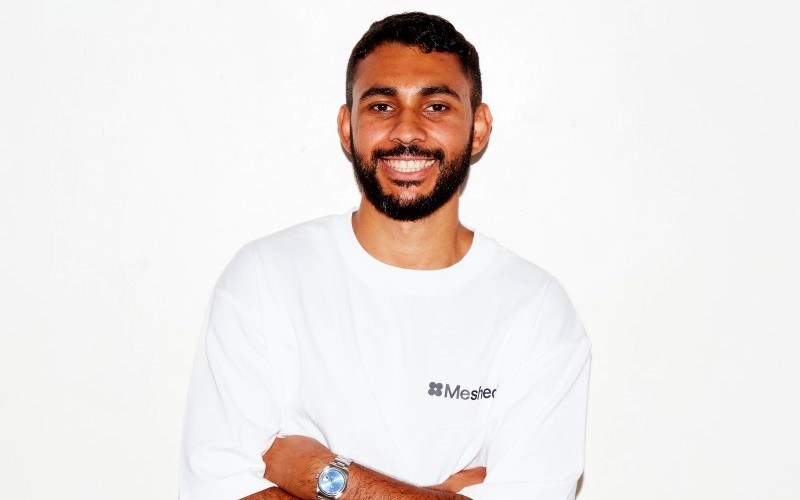Do you remember when The Terminator was used to illustrate articles about AI?
Thankfully the days where heyday Arnie heralded the oncoming apocalypse are long gone. Today the fear around AI is often of missing out, rather than being wiped out.
Take the insurance industry. It’s as old as the hills and, based as it is on a fragile trust between customer and provider, has seemed (perhaps rightfully) reluctant to go all-in on technology.
Yet as awareness and the use-cases of AI grows seemingly by the day, that tipping point has been reached where the risk of being left behind perhaps outweighs the need to proceed with caution.
Jake Wells (pictured, main image) is co-founder and COO at Meshed, which featured on our 2025 InsurTech 50, published today.
The startup’s platform connects a business’s data to offer precisely the right insurance coverage in real-time from top insurers – cutting commission fees by up to 30%.
“AI is not going to bite you,” Wells told me following a BusinessCloud roundtable in Canary Wharf last week focused on the technology’s potential to impact insurance. “Businesses shouldn’t be scared of it. Don’t get left behind.
“There have been major technology shifts within insurance, from Direct Line using phone; to web; then cloud. I think this is just going to be another one [of those shifts]… there are going to be some winners, and there are going to be some losers.”
Disruption
Andy Beal is associate director of architecture and innovation at Markerstudy, one of the largest managing general agents in the UK. With a strong presence in the UK motor insurance market, the firm specialises in niche motor cover.
Beal has designed and led developments around data lakes with over 10 billion records, as well as implementing architectural frameworks and governance.
“It’s going to hugely disrupt the insurance industry – both the internal processes, and the way in which we interact with customers – and we need to accept that,” he said.
“We [as an industry are] going to fail [when using this technology], but hopefully our successes will outweigh those failures. It’s very similar to the pharmaceutical world, where 100 drugs will fail and one will succeed – but that one will pay for all the failures.
“My biggest concern is that people are forgetting fundamental IT principles when it comes to AI. They think it’s a completely new technology, and forget everything they’ve learned over the years – but AI is just another technology.
“It’s also not just a technology problem, but a business problem. If we get that right, we can completely transform insurance.”
Richard Robinson is general manager of Insight at Confused.com, which launched in 2002 as the UK’s first comparison platform for car insurance. It has since grown into a marketplace for more than 30 products across vehicle, home, travel, energy, life, mortgage, pets and more.
Insight is described as the most comprehensive index for new business car insurance policies in the UK.
“I love the way that people are bringing up data, because data is the lifeblood of an organisation, and it’s the fuel that drives AI – so you absolutely have to have the right data to do [it properly],” he told attendees in the boardroom of the Level39 tech hub.
Gesturing above his head, he continued: “I see AI right now as the classic Gartner hype cycle: we’re up there at the moment… but it will fall down again.
“Once we start to really demonstrate and prove the value of AI, I think it will then become more mainstream.”

Carly Gulliver (above), partner at law firm Addleshaw Goddard LLP, provides legal advice on mergers and acquisitions, management buyouts, private equity investments and restructuring.
“From my perspective as a transactions lawyer, AI is an exciting growth story and opportunity for investors,” she said. “It has lots of plus points, from a scalability, internationalisation and evolving technology perspective – but challenges exist around due diligence, increased regulation, cybersecurity, data protection and intellectual property.”
Challenger brands
Gulliver says larger businesses are now actively discussing AI at board level, although the nimble and focused nature of startups means they are more capable of incorporating the technology quickly and appropriately.
Tom McMorrin, former head of insurance at Juniper, has seen this first-hand: Juniper, a startup which aimed to provide reproductive health insurance for everybody, was acquired by Fertifa, the UK and Europe’s leading reproductive benefits provider.
“We will start to see a lot of the challenger InsurTechs either growing at a much higher rate than the larger insurers, or being acquired [by those insurers who wish] to take them out of the market and incorporate their tech,” he said.
“A lot of Proof-of-Concepts [at incumbents] never make it to trial as there’s a lot of risk aversion in the higher-level C-suites. If you’re dealing with board members and investors, and a trial perhaps has an error or isn’t quite as efficient, there’s a lot of reticence to continue.
“Whereas if you’ve suddenly seen generations of new founders with higher levels of risk appetite and experience in these sectors, the product invariably will do better. And so it’s then comparing larger, slower incumbents, with more nimble, risk-seeking companies.”
Ian Taylor, head of CX at Bury-based tech consultancy Avoira, agrees that achieving boardroom buy-in is difficult – but can be achieved. The hardware and software provider has completed projects for Principal Insurance (a vulnerable customers identification tool) and Revolution Insurance (an AI speech analytics platform).
“There is a general trend in the boardroom of nervousness, of over-investing in an expensive product and not getting the return,” he explained.
“We take customer interactions then provide insight into the truth of what’s happening, and have seen how data can overwhelm a business: they don’t know where to look, then they’re burning time and resources, unfocused, in an attempt to achieve any kind of use case.
“So reel it back a bit. Do a proof of value that aligns to your business case; prove it; get the return; then move on to the next one.
“Being overwhelmed with garbage data – AI slop – is the risk. When you are precise and prove that AI can deliver a use-case on a customer’s data, then you get the trust – and then the projects ramp up very quickly and can be successful.”
Sputnik Digital is an innovation, UX, engineering and AI agency with 25 years of experience working with financial services clients including Swinton, GoCompare, Fluent Money and Hastings.

At the roundtable, MD Andy Nicol (above) demonstrated its approach to creating technical proof-of-concepts and analysing commercial viability for clients. As well as numerous projects delivered inside of client businesses, Sputnik have also built https://www.hollr.io/ and https://www.invntry.co/.
Nicol concurs with Taylor. “The danger of jumping all-in on AI is doing so in an unstructured, unfocused way, without looking where the value is.
“Good practice would be to focus down and tackle small tasks via AI microservices that do individual, small things and which also make it easier for the human brain to wrap around the due diligence and the guardrails and everything else that you need.”
Tom Robertson, product owner at Lockton, a privately owned insurance brokerage and risk management firm, says the danger is at a lower level of product development, whether tailoring AI to internal or external customers.
“From auto generating your requirements through to staying close to your customer, asking the question of whether software is the answer at a high level, or whether you need to adapt your business around it… that’s what I’ve faced within the product development space,” he said.
Changing landscape
Ade Webb (below), executive chair of Outcome Path, took esure from a startup in 2002 through an MBO in 2010 and onto a £1.3bn IPO in 2013. He was also the longest-serving non-executive director at Gocompare, helping it to an almost £600m trade sale.

Webb says the public’s increasing use of tools such as ChatGPT on a personal level highlight the need to reshape how the technology is used to deliver products to them.
“The biggest problem is this short-term efficiency window where, if you don’t do something to improve your efficiency, you’re at a loss,” he reflected. “If that’s your only focus, you’re ignoring the fact that you’re going to be in a changed choice and trust landscape for consumers… because they have access to exactly the same things as the big companies do.
“You have to solve the problem directly in front of you, and then you’ve got a chance during the efficiency landscape. But if the board and the senior leadership team are not thinking beyond that to what the consumer is going to be like, then they’ll reduce the value in the company in three-to-five years’ time.”
Eloise Hibberd (below), operations director at e-Zee Insurance Solutions – which provides strategic consultancy and IT support services within the insurance industry – says she will watch with interest how its clients evolve and which toolsets they decide to use.
e-Zee also featured on the 2025 InsurTech 50, published today.
“For now, they rely on a lot of human interaction,” she said. “A small MGA can’t be reckless in what they try.”
She added: “AI is only ever as good as the data that gets put in. Over the next three to five years, it’ll be really interesting to see how that data evolves. And if we do end up coming back to that human side – and I suspect we will – my developers will be very happy.”

Michael Westcott is a product & innovation solicitor at Weightmans. He says the law firm’s approach with AI is “to support – not supplant – the human decision-making process”.
“There is a level of managed expectations – you might even call it mistrust – towards some of the outputs that you’re going to get because it isn’t yet getting things absolutely right every single time,” he added.
“On the flip side, there are people that maybe trust it a bit too much without understanding the technology. It’s not the silver bullet yet – but it is certainly going to improve efficiencies.”
Trust is paramount
Robinson, head of Insight at Confused.com, says a balancing act is needed when it comes to maintaining trust with customers.
“How do you design systems to drive efficiency and optimise for machine learning and AI whilst balancing that with building and maintaining trust with consumers?” he asks.
“However businesses cannot allow consumers to get ahead of them. They must keep pace or be ahead of consumer needs, requirements and expectations; because as soon as you drop behind that, then you’re really going to struggle to make up that space.”
Wells of Meshed urges that they “ask the right questions to data providers”.
“If you’re using AI for underwriting or pricing, and someone’s telling you that you can make efficiencies there, ask ‘what is the underlying data behind that?’
“Validate it so you’re not going to run into any discrimination or bias issues.”
McMorrin says the challenge is balancing a highly commoditised product that some consumers want to purchase – and some have to purchase – within a highly regulated industry.
“You cannot include discrimination within a pricing model, and if you need to query the reasons for a given price, you have to give a regulated answer to explain that price,” he explained.
“We’ve hit a huge wave of AI within the insurance sector for efficiencies, and I think it’s generated a new wave of InsurTechs – but there will be a resurgence of human-led interactions to offset that trust imbalance with insurance.”
Discordant, marvellous tech
Webb, chair of Outcome Path – which has consulted and built AI applications for the likes of eSure, HSBC, Bayer, Google, Mazda and Unilever – says: “AI is what’s known as discordant technology – where the technology changes faster than social norms, regulatory norms and legislation can keep up with.
“The big problem with that is the unregulated versions then outperform the regulated versions.”
Nicol of Sputnik Digital had the last word: “You saw the images of auto-generated people with six fingers. But just take a second and marvel at this technology!
“The future is already here – it’s just not widely distributed. The people who are creating these models can see the same things we can, and it’s the worst it’s ever going to be.
“I remember looking at Rightmove many years ago and thinking: that’s dead easy to build, it’s the simplest ‘data in, data out’ directory. And yet it disrupted a sector because of technological change.
“I guess now there is a chance to disrupt Rightmove.”


